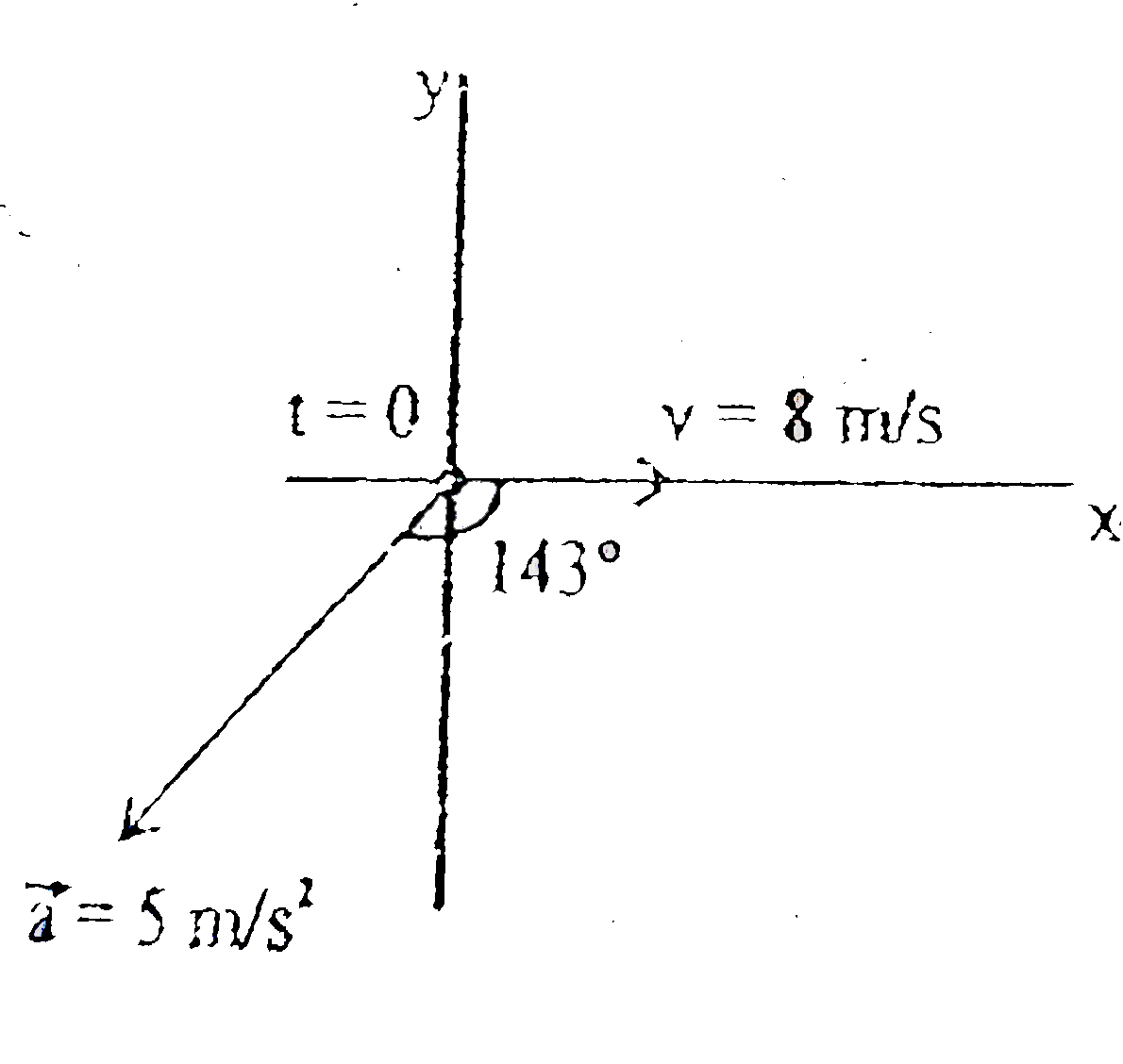A particle moves in the x-y plane with the velocity ¯v=aˆi−btˆj. At the instant t=a√3/b the magnitude of tangential, normal and total acceleration are _&_.
The correct Answer is:√3b/2,b/2,b
To solve the problem, we need to find the tangential, normal, and total acceleration of a particle moving in the x-y plane with a given velocity. The velocity is given as:
→v=a^i−bt^j
Step 1: Find the acceleration
Acceleration →a is the rate of change of velocity, which can be calculated by differentiating the velocity with respect to time t:
→a=d→vdt
Differentiating the given velocity:
→a=ddt(a^i−bt^j)=0^i−b^j=−b^j
Step 2: Calculate the velocity at the given time
We need to find the velocity at the instant t=a√3b:
→v=a^i−b(a√3b)^j=a^i−a√3^j
This simplifies to:
→v=a^i−a√3^j
Step 3: Determine the angle of the velocity vector
To find the angle of the velocity vector, we can calculate the components:
- vx=a
- vy=−a√3
The angle θ can be found using:
tan(θ)=vyvx=−a√3a=−√3
This gives us:
θ=−60∘(or equivalently, 120∘ in standard position)
Step 4: Calculate tangential and normal acceleration
1. Tangential Acceleration (at): This is the component of acceleration in the direction of the velocity. Since the acceleration is purely in the negative y-direction, we can find the tangential acceleration using the angle:
at=|→a|cos(30∘)=b⋅√32
Thus, the magnitude of tangential acceleration is:
at=√3b2
2. Normal Acceleration (an): This is the component of acceleration perpendicular to the velocity. It can be calculated using:
an=|→a|sin(30∘)=b⋅12
Thus, the magnitude of normal acceleration is:
an=b2
Step 5: Calculate total acceleration
The total acceleration is the vector sum of tangential and normal accelerations. Since they are perpendicular, we can use the Pythagorean theorem:
|→atotal|=√a2t+a2n=
⎷(√3b2)2+(b2)2
Calculating this gives:
|→atotal|=√3b24+b24=√4b24=√b2=b
Final Results
- Tangential acceleration: √3b2
- Normal acceleration: b2
- Total acceleration: b
- vy=−a√3
⎷(√3b2)2+(b2)2
- Normal acceleration: b2
- Total acceleration: b
Topper's Solved these Questions
- CIRCULAR MOTIONBOOK - ALLENCHAPTER - CIRCULAR MOTIONEXERCISE - Dynamics of circular motion
6 Videos
- CIRCULAR MOTIONBOOK - ALLENCHAPTER - CIRCULAR MOTIONEXERCISE - EXERCISE(S-2)
6 Videos
- CIRCULAR MOTIONBOOK - ALLENCHAPTER - CIRCULAR MOTIONEXERCISE - EXERCISE (J-A)
6 Videos
- BASIC MATHSBOOK - ALLENCHAPTER - BASIC MATHSEXERCISE - Question
1 Videos
- CURRENT ELECTRICITYBOOK - ALLENCHAPTER - CURRENT ELECTRICITYEXERCISE - EX.II
66 Videos
Similar Questions
A particle moves in the x-y plane according to the law x=at, y=at (1−αt) where a and α are positive constants and t is time. Find the velocity and acceleration vector. The moment t0 at which the velocity vector forms angle of 90∘ with acceleration vector.
View SolutionThe velocity varies with time as →v=aˆi+btˆj , where a and b are positive constants. The magnitude of instantaneous velocity and acceleration would be
View Solution
Knowledge Check
A particle moves in the x-y plane with velocity vx=8t−2andvy=2. If it passes through the point x =14 and y = 4 at t =2s the equation of the path is
A1. x=y3−y2+2B2. x=y2−y+2C3. x=y2−3y+2D4. x=y3−2y2+2
A particle moves in the x-y plane with velocity vx=8t−2andvy=2. If it passes through the point x=14andy=4att=2s, the equation of the path is
View SolutionA particle moves in the x-y plane with velocity vx=8t−2andvy=2. If it passes through the point x=14andy=4 at t = 2 s, the equation of the path is
View SolutionA particle is moving with a velocity of →v=(3ˆi+4tˆj)m/s. Find the ratio of rangential acceleration to that of total acceleration at t=1sec
View SolutionA particle moves in a circular path of radius R with an angualr velocity ω=a−bt, where a and b are positive constants and t is time. The magnitude of the acceleration of the particle after time 2ab is
View SolutionA particle is moving along a circular path ofradius R in such a way that at any instant magnitude of radial acceleration & tangential acceleration are equal. 1f at t = 0 velocity of particle is V0. Find the speed of the particle after time t=(R)/(2V0)
View SolutionAn object is moving in x−y plane its velocity and acceleration at t=0 are represented in figure.

The ratio of magnitude of velocity to magnitude of component of acceleration along velocity at t=0 :-
View SolutionThe coordinates of a particle moving in x-y plane at any time t are (2t,t2). Find (a) the trajectory of the particle, (b) velocity of particle at time t and (c) acceleration of particle at any time t.
View Solution
